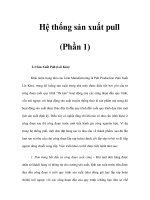SIGN with your BABY phần 1 pptx
Bạn đang xem bản rút gọn của tài liệu. Xem và tải ngay bản đầy đủ của tài liệu tại đây (2.56 MB, 10 trang )
SIGN with your BABY.
How to Communicate with
Infants Before They Can Speak
Joseph Garcia
Published by
SIGN
ME
—.
Sign2Me™ is an imprint and
trademark of Northlight Communications, Inc.
11395 Fifth Avenue NE, Suite B
Seattle, WA 98125-6108
More information about SIGN with your BABY products
can be found in the back of this book.
Copyright © 1999, 2000, 2001 and 2003 by Joseph Garcia
1st Printing 1999, 2nd Printing 1999, 3rd Printing 2000, 4th Printing 2001,
5th Printing 2003.
This book is based on information originally presented in the book, Toddler
Talk, written by Joseph Garcia. Toddler Talk is no longer in print.
Printed in Canada
All rights reserved. No part of this book may be reproduced or transmitted
in whole or in part, in any form or by means electronic or mechanical,
including photocopying, recording or by any information storage and
retrieval system without written permission from the author and publisher,
except for the inclusion of brief quotations in a review. For information
contact Northlight Communications, Inc.
Notice of Liability-Disclaimer
The information in this book is developed from public information, educa-
tional sources, and the author's personal observations. No claim is made as
to the results of using the information contained in this book. Neither the
author nor Northlight Communications nor Stratton-Kehl Publications, Inc.
shall have any liability or responsibility to any person or entity with respect
to the results of the book's suggested techniques.
Library of Congress Catalog Card Number 98-89288
ISBN 0-9668367-7-4
Cover Design
Graphica
Communication
Solutions
Illustrations
Gregory Maes
Heather Nystrom
Lola Roberson
Joseph Garcia
Cartoons
Matt Anderson
Layout
Terry Stratton
Dara Burrows
Joseph Garcia
Stephanie Hopkinson
Proof Reading
Barbara J. Miller
I want to give special thanks to Dara Burrows, my wife, for her
patience and persistence in transforming my thesis into a read-
able guide. I also thank John Herum for his technical guidance.
I am grateful to the early childhood development researchers
whose studies continue to help us become better parents. And a
special acknowledgment goes to Dr. Glenn Massay who encour-
aged me to investigate my idea, test my theories, and write this
book.
Printed on recycled paper with soy ink.
For my parents, Emma and Bill Garcia,
who taught me that through learning
and loving, I could do anything.
FOREWORD
Certain very important facts about human language have been
known for many years. Two thirds to three quarters of all everyday
language is ordinarily acquired by the third birthday. Also, in cases
of poor educational performance, inadequate language ability is
almost invariably present. What has not been known, surprisingly,
is what exactly goes on during those first three years that underlies
the acquisition of language. The reason for this strange state of
affairs is that the research community has largely neglected the
details of development during these early years. Recently, however,
important progress has been made.
Even some thirty years ago reports appeared that indicated
that children taught sign language had acquired about seventy-
five signs by the time they were nine months old. In contrast, the
typical child of that age could understand fewer than ten words,
regardless of how bright she was.
This was a tantalizing though isolated finding. Until fairly
recently, no one in developmental research followed up on this
potentially important finding. Now two programs have. One of
them is the subject of this book.
I recommend the teaching of signs, starting at about seven
months of age, for several reasons. First, sign language represents a
second language, and our research consistently showed that when
a second language was introduced in an effective manner to a child
from the early months on, the child would not only become
bilingual by the second birthday, but would be ahead of the
monolingual child in both languages! Indeed, that has been the
experience of parents in our program.
Second, we have repeatedly found that children, especially
boys, though developing well, have few or no spoken words at all
until their second birthdays. We have also learned that the period
between seventeen and twenty months of age is a particularly
difficult time, in that the normal child is very limited in regard to
frustration tolerance, and being unable to express himself
exacerbates the problem. A child who can sign at that stage of life
is a child who will cause considerably less frustration for himself
and his parents. That means the attachment process can move
along much more smoothly and probably to a better outcome.
Finally, the potential for understanding mental activity in
children between eight and twenty-two months of age that is
made possible by sign language is intriguing. Someday soon we
will take advantage of this remarkable tool to get a much more
refined picture of how the mind of a child evolves.
For all these reasons, and because his work is sound, I strongly
recommend this groundbreaking work of Joseph Garcia.
Burton L. White, Ph.D., June 1998
Director, The Center for Parent Education
Author, The First Three Years of Life and
Raising a Happy Unspoiled Child
CONTENTS
Communication: The Backbone to a Healthy
Relationship With Your Child 9
911 ToCallorNottoCall? 11
Proving an Intuition 13
Get the Big Picture 15
Something Done Wrong Long Enough Becomes Right? 15
Why the First Signs of Intelligent Life Can Be Signs 17
"Even Though I Can't Talk Yet, I Know More Than
You Think I Know" 19
How Your Child's Cognitive Skills and Motor
Coordination Develop During Infancy 20
Seeing the World Through a Newcomer's Eyes 21
Shared Perception and Shared Meaning 21
Learning by Association 23
Will Signing Interfere With My
Child's Speech Development? 24
To Contribute or to Commit? 25
How to Sign With Your Baby 26
Let Your Fingers Do the Talking 26
Gazes: Opportune Moments to Introduce Signs 26
Let's Face It 28
The First Signs of Intelligent Life 29
How To Show Your Infant a Sign 29
Which Signs to Start With and When to Start 31
"Can You Tell Me Where It Hurts?" 39
Some Handy Games 41
Recognizing Your Children's Signs 43
Repeating and Reinforcing Your Signs 46
Combining Signs 48
How to Create a New Sign 48
The Power of Silence 49
Things to Remember 50
The Terrible Twos and Threes:
Talk Your Child Out of Them 51
Final Thoughts 52
Hand Shapes 55
Vocabulary 57
References 107
Index 108
COMMUNICATION: THE BACKBONE TO A HEALTHY
RELATIONSHIP WITH YOUR CHILD
From the moment babies are born, these tiny human beings
start communicating with the world around them. The vital
connection between you and your infants depends on this
communication. Infants will use extensive body language, facial
expressions, and all sorts of verbal sounds to interact with you.
These movements and sounds will eventually evolve into language.
But until they do, you may have an incredibly difficult time
understanding your infants' attempts to tell you things.
How many times have you wished you could look into your
babies' minds and know what was going on in there? How many
parents have felt the instinctual longing to extract a thought or a
word from their troubled infants? The inability to understand
your infants is certainly not because you don't try hard enough,
nor is it because the infants abandon their attempts to express
themselves. Infants have an instinctual need to communicate with
you, just as you have an instinctual need to understand them.
Infants are born with abundant intelligence. However, they
have a limited means to let you know what their thoughts and
needs are. The muscles that allow speech to form are
undeveloped, restricting the infant from participating in verbal
language. Imagine how it must feel to be a baby who has many
specific needs and thoughts to express, but has no effective way to
make those specific needs or thoughts understood. At times, it
must be frustrating for these small and socially dependent beings
to live with these limitations.
Communication is one of the highest forms of social
interaction. Leading researchers in infant behavior have deter-
mined that social interaction is crucial to all infants' development.
They have further concluded that for a caregiver to withhold social
responses to an infant's attempts to communicate is one of the
most disruptive things that can occur in the infant's learning
process.
What can you do to encourage this learning process? Here
is where Sign with your Baby can contribute to your infants'
development. Imagine how your babies might feel if one day
you started using simple hand movements to communicate.
Let's say you make a particular motion during a certain daily
activity, such as eating. Soon your infants associate that movement
with the situation or activity that was taking place when the
motion was introduced. They begin to experiment with their own
hands and discover they can replicate the movements you make.
Receiving reinforcement from you, babies quickly learn that
by making this motion, they can communicate their needs
and wants.
The time between birth and when your infants utter their first
recognizable words can be a time of miscommunication or a
time when your communication is less than precise. This does not
have to be the case. These precious months can be rich in
meaningful and effective infant/parent interaction. Using manual
communication with your infants can help build a solid
foundation for mutual understanding, dramatically contributing
to the bonding process.
911 TO CALL OR NOT TO CALL?
As a parent, I found that there was nothing more frightening,
frustrating, or heartbreaking than when my young toddler came
to me crying and I had no idea what was wrong. I can remember
being a toddler and not understanding why the rest of the world
didn't know what I was feeling. It never dawned on me that
it would take more than crying to let my parents know what was
wrong.
The somewhat unusual anecdote that follows illustrates, first
of all, that strange and scary things really can happen to your
toddler. It also shows one extremely practical reason for learning
some simple signs.
Imagine your toddler Juliet is eleven months old and just
learning to walk. She hasn't made her first solo step, but she can
really cover some ground balancing herself against the couch. She
is doing just that when she plops down onto her bottom, rolls
over on her tummy, and happily explores the floor underneath
the couch.
She laughs and coos and makes her delightful infant noises.
She's been exploring her vocal chords lately, and has come up with
some wild sounds. But she hasn't said any clear words yet, other
than mama, papa, "bye bye" and "uh oh".
Suddenly her bubbling banter turns to a distressed whimper.
She sits up and turns to find you. You are sitting nearby
wondering what happened. Then Juliet looks at you intently and
stops her crying for a moment while she raises her hands and
bumps the tips of her index fingers together in front of her nose.
You recognize her hand motion—it means pain. You've been
showing her this sign for about three months. After watching you
do it, now she can make the sign. And, not only does she know
what the sign means, but she can use it to tell you about her pain.
You pick Juliet up, thinking to yourself, "She made the gesture
in front of her nose, so that's where she must hurt." You examine
her nose. "Hmmm it looks okay, but she's still crying. Maybe
she bumped her nose on the floor."
Then she looks at you and repeats her sign in front of her
nose. You wonder, "What can be wrong?" You bend her head
back slightly and look a little closer. That's when you see
something lodged way up inside her nostril. It's her brother's toy
train wheel that broke off his train that morning.
You carefully remove the wheel from Juliet's nose, and soon
her crying stops. She looks at you with satisfaction. She was
able to tell you what was wrong. You were able to respond. What
a relief!
PROVING AN INTUITION
I've always been intrigued by manual language, even though
no one in my family is deaf. So, in 1975,1 learned American Sign
Language. I enjoyed signing and soon began using it in my work
and social life. I was spending time with my deaf friends, some of
whom had hearing children. I noticed that hearing children of
deaf parents started communicating with sign language at an
earlier age than other hearing children did with words.
Intrigued by this observation, I decided to research early
childhood language acquisition and the part sign language could
play in this process. In 1986, I was in graduate school and chose
this topic for my thesis. I read about the research that had already
been done in pre-speech communication and became especially
inspired by the work of Margaret Bullowa, Katherine Nelson,
and Timothy Moore. These researchers confirmed that pre-speech
infants have the intelligence to communicate specific thoughts
and needs.
As I researched further, I found plenty of information on deaf
children and their language development. But I couldn't find
much information on hearing children using sign language (such
as siblings of deaf children using signs). I wondered, what would
be the result of using signs for early communication between
hearing children and hearing parents. The more I researched, the
more I became convinced that I was uncovering a treasure!
My next step was to find out how much earlier a child could
communicate with signs than with words. After consulting with
experts in infant development and conducting field research, I
concluded that you can begin parent/infant communication at
eight months using signs, rather than waiting for comprehensible
speech to develop at sixteen to eighteen months.
The births of my two sons in 1985 and 1987 gave me perfect
opportunities to develop and use the method of teaching signs
to babies. Looking into my new-born sons' eyes, I could see and
feel their innate intelligence and their desire to communicate. It
was exciting to be living out, in my day-to-day interactions, the
theories and ideas I had been researching. It's hard for me to put
into words how wonderful I felt when my sons began to
communicate with me at such an early age. Our communication
helped me become more in tune, not only with my children, but
also with myself as a parent.
Many other parents have also experienced these rewards.
Parents participating in my studies included parents with no
signing experience and some with limited signing experience. All
the parents were surprised at how young their infants were when
they started signing. They were also extremely grateful for this
tool. Since the printing of my book, Toddler Talk, thousands
of families have successfully learned how to sign with their
babies.
GET THE BIG PICTURE
To get the big picture, please read the entire book before you
try anything with your infants. It's important that you understand
what's involved in infant communication before you start
introducing signs. There's a little bit of background and discussion
followed by how-to steps and suggestions. The vocabulary section
at the end of the book has drawings and instructions explaining
each sign. You can use the vocabulary section as a workbook
and keep track of your child's progress, or write notes and
reminders to yourself.
SOMETHING DONE WRONG LONG ENOUGH
BECOMES RIGHT?
Believe it or not, in the 1930s many pediatricians in this
country told parents that infants were too fragile to be picked up
or cuddled. People actually viewed holding and touching infants
as something harmful. Most parents followed this advice. Finally,
in the 1940s, a publication refuting this view went around the
country and this attitude began to change. Not until then were
parents advised that it was okay to pick up and play with
their infants.
Although it may be difficult to imagine that so recently in
our history infants were seldom cuddled or caressed, this was the
norm. Similarly, for years people have seen manual
communication only as a tool for the Deaf. I've encountered
people with the attitude that a person who signs is defective or
somehow less than normal—whatever "normal" means.
Fortunately, we are constantly discovering and adopting more
sensible ways to approach new and different things.
Communication, like physical contact, is an essential
component in our children's development. We can benefit from
the powerful gift the Deaf have given us. That gift is actually a
treasure waiting to be unlocked. And the key to that treasure is
in your hands.
WHY THE FIRST SIGNS OF INTELLIGENT LIFE
CAN BE SIGNS
Most people haven't used sign language, so it may be hard
to imagine communicating without spoken words. This is why
many parents wait until their child can clearly speak before they
earnestly begin to focus on two-way communication. However,
recent studies indicate that children can absorb and communicate
information shortly after birth.
Authorities suggest that 90% of the information we absorb is
received through our vision. This means visual acuity is extremely
important in our overall development. Infants will naturally use
vision to help guide them through the early months of life.
Infants naturally use smiling, cooing, and crying to
communicate their needs and feelings. They understand a lot
about themselves and the world around them. What they lack is a
precise way to express themselves, such as "Mommy, my stomach
hurts" or "I want more food."









